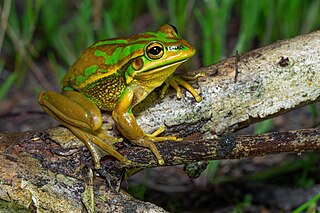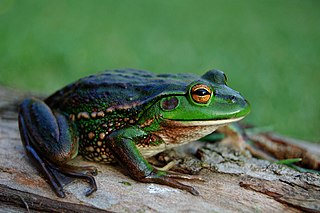
The green and golden bell frog, also named the green bell frog, green and golden swamp frog and green frog, is a species of ground-dwelling tree frog native to eastern Australia. Despite its classification and climbing abilities, it does not live in trees and spends almost all of its time close to ground level. It can reach up to 11 cm (4.5 in) in length, making it one of Australia's largest frogs.

Ranoidea chloris, commonly known as the red-eyed tree frog or orange-eyed tree frog, is a species of tree frog native to eastern Australia; ranging from south of Sydney to Proserpine in mid-northern Queensland.

The growling grass frog, also commonly known as the southern bell frog, warty swamp frog and erroneously as the green frog, is a species of ground-dwelling tree frog native to southeastern Australia, ranging from southern South Australia along the Murray River though Victoria to New South Wales, with populations through Tasmania. This species' common names vary between states; the name southern bell frog applies to New South Wales, growling grass frog in Victoria and South Australia, and green and gold frog in Tasmania. This species has been introduced to New Zealand.

The Blue Mountains tree frog also called the variegated river tree frog is a species of tree frog in the subfamily Pelodryadinae. It is endemic to southeastern Australia and is found in eastern Victoria and in southeastern New South Wales. The Jenolan Caves tree frog, a population formerly separated as Litoria jenolanensis, is nowadays included in this species.

The leaf green tree frog is a species of stream-dwelling frog, native to eastern Australia from the Queensland/New South Wales border south to Sydney.

Lesueur's frog is a species of ground-dwelling tree frog native to south-eastern Australia, from Sydney, New South Wales, to eastern Victoria.

The southern brown tree frog, also known as the brown tree frog, whistling tree frog, or Ewing's tree frog, is a species of tree frog native to Australia: most of southern Victoria, eastern South Australia, southern New South Wales from about Ulladulla—although this species is reported to occur further north—and throughout Tasmania including the Bass Strait Islands, in which state it is the most frequently encountered frog. It has been introduced to New Zealand, where it can be locally abundant.

The mountain stream tree frog is a species of tree frog native to highland areas of NSW, Australia stretching from the Myall Lakes area, north to around Dorrigo National Park and west to Barrington Tops National Park.

Pearson's green tree frog, also known as the cascade tree frog, is a species of tree frog inhabiting rainforest creeks from north of Lismore, New South Wales, to Kenilworth, Queensland, with a disjunct population at Kroombit Tops Queensland, Australia.

The dainty green tree frog, also known as the graceful tree frog, is a species of tree frog in the subfamily Pelodryadinae. It is native to eastern Queensland, and north-eastern New South Wales, Australia and ranges from northern Cape York in Queensland to Gosford in New South Wales, with a small and most likely introduced population in Hornsby Heights in Sydney. It is the faunal emblem of the City of Brisbane.

The striped rocket frog, or in its native range known as the rocket frog, is a species of frog that occurs mostly in coastal areas from northern Western Australia to around Gosford in New South Wales at its southernmost point, with a disjunct population occurring further south at the Sydney suburb of Avalon. It also inhabits the southern lowlands and south east peninsula of Papua New Guinea.

The peppered tree frog is a species of frog in the subfamily Pelodryadinae. It has a green back speckled with black, a cream-coloured belly and a dark stripe running from the shoulder. It is endemic to a very small area of the Northern Tablelands of New South Wales, Australia where it is known from five stream systems. It has not been observed in the wild since the 1970s, but a frog of very similar appearance has been observed in an area slightly further north, and it is not clear whether these are examples of the peppered tree frog or an outlying population of Pearson's green tree frog. The International Union for Conservation of Nature has assessed the peppered tree frog's conservation status as being "data deficient".

The striped burrowing frog is a species of burrowing frog in the subfamily Pelodryadinae of the family Hylidae. It occurs throughout much of Australia, from northern New South Wales, through eastern and northern Queensland and into eastern Northern Territory. This species was once included in the genus Litoria or Cyclorana.

The motorbike frog is a ground-dwelling tree frog of the subfamily Pelodryadinae found in Southwest Australia. Its common name is derived from the male frog's mating call, which sounds similar to a motorbike changing up through gears; it is also known as Moore's frog, the western bell frog, western green and golden bell frog, and western green tree frog.

The New Holland frog, also known as wide-mouthed frog, is a large species of burrowing frog native to northern New South Wales and the eastern portion of Queensland, Australia.

The rough frog, also known as the woodland water-holding frog, warty water-holding frog, and red-backed cyclorana, is a species of treefrog native to northern New South Wales and south-eastern Queensland, Australia.

The Australian waterfall frog or torrent treefrog is a species of tree frog native to Far North Queensland, Australia. The common name "waterfall frog" is indicative of its habitat of moist, rocky streams, and is often found along waterfalls within its range.

Davies' tree frog is a species of frog in the subfamily Pelodryadinae. It is endemic to Australia. Its natural habitats are subtropical or tropical dry forests, subtropical or tropical moist lowland forests, subtropical or tropical dry shrubland, and rivers. It is currently threatened by habitat loss.

The New England tree frog or glandular tree frog is a species of frog in the subfamily Pelodryadinae, endemic to Australia. Its natural habitats are temperate forests, subtropical or tropical moist lowland forests, subtropical or tropical moist montane forests, temperate shrubland, rivers, and pastureland. It is threatened by habitat loss.
Watson's tree frog, also known as the large brown tree frog or southern heath frog, is a species of tree frog endemic to south-eastern Australia.



















